|
< Earlier Kibitzing · PAGE 5 OF 14 ·
Later Kibitzing> |
| Jan-11-08 | | CapablancaFan: Video instruction and commentary on this very fine game.http://www.youtube.com/watch?v=0d52... |
|
| Jan-11-08 | | InspiredByMorphy: 16. ...Na5? did nothing for black. If black wanted to get the knight in the game one plan of action may have been ...Nd8,Nf7,Nh6 and possibly even Ng4 . Although its a long trek the position seems more closed than open and I would think the knight would do well playing an active part. |
|
Jan-11-08
 | | Jimfromprovidence: With modern analysis, it looks like if black had simply played 36...a6 instead of getting greedy with 36...Rf3, the game would have been a draw. It's a shame that the video review just rehashed the text and did not provide any newer scrutiny. |
|
Jan-12-08
 | | Jimfromprovidence: To clarify and expand on my previous post, I'm trying to reexamine this classic match to see if black can obtain a draw by first creating a passed pawn on the b file. The specific proposed line is as follows:
36...a6 37 g6 b5 38 axb5 axb5 39 Kg5 b4 40 Rf7+ Kg8 41 Rxf5 Rg3+ 42 Kh5 b3 43 Rxd5 b2 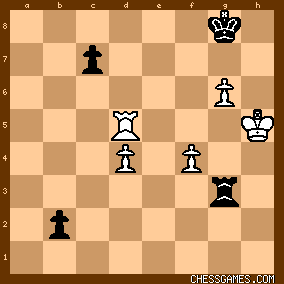
click for larger viewI envision that this position leads to a draw. |
|
| Jan-12-08 | | Calli: <Jimfromprovidence> You may be right about a6, but better after 36...a6 37 g6 b5 38 axb5 axb5 39 Kg5 b4 40 Rf7+ Kg8 is 41 Rd7 because the K is going to capture on f5 anyway 41...b3 42.Rxd5 b2 43.Rb5 Rc2 |
|
Jan-12-08
 | | Jimfromprovidence: <Calli> <You may be right about a6, but better after 36...a6 37 g6 b5 38 axb5 axb5 39 Kg5 b4 40 Rf7+ Kg8 is 41 Rd7 because the K is going to capture on f5 anyway 41...b3 42.Rxd5 b2 43.Rb5 Rc2> Thanks for bringing up 41 Rd7. I hadn’t seen it.
Below is your continuation.
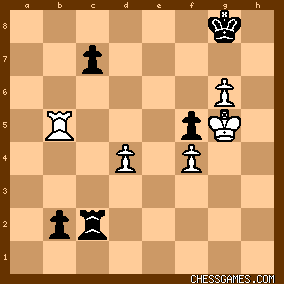
click for larger viewContinuing with this line, it appears that white ends up with his rook and the f pawn vs. the black rook. I could not determine a way how white can convert the advantage, though. |
|
Jan-12-08
 | | beatgiant: <jimfromprovidence>
After 36...a6, what about the immediate <37. Rd7>. Then 37...c6 would take away the c6 square for Black's rook, so 38. g6 b5 39. Kg5 bxa4 40. Kf6 breaks through with a big advantage similar to the actual game. Or if 36...a6 37. Rd7 b5 38. axb5 axb5 39. Rxd5 b4 40. Rxf5+ looks like a big advantage too. White's rook will stop Black's pawn from behind, and White's two connected passed pawns supported by king and rook will be hard to stop. |
|
Jan-13-08
 | | Jimfromprovidence: <beatgiant> <After 36...a6, what about the immediate <37. Rd7>. Then 37...c6 would take away the c6 square for Black's rook, so 38. g6 b5 39. Kg5 bxa4 40. Kf6 breaks through with a big advantage similar to the actual game. Or if 36...a6 37. Rd7 b5 38. axb5 <beatgiant> axb5 39. Rxd5 b4 40. Rxf5+ looks like a big advantage too. White's rook will stop Black's pawn from behind, and White's two connected passed pawns supported by king and rook will be hard to stop.> Black would go back to the move in the text, 37...Rf3, seeing 38 g6 Rxf4+ 39 Kg5 Re4 40 Kf6 Re8, which holds for black. 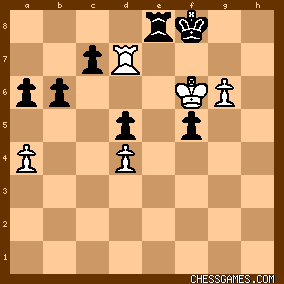
click for larger viewThe difference in the positions is that since the white rook has moved from h7, white no longer has the mate threat he had after move 39 Kg6 in the text. Black doesn't lose a tempo and material, as he did in the text. |
|
Jan-14-08
 | | beatgiant: <Jimfromprovidence>
You are right.
Another try for White is 36...a6 37. g6 b5 38. axb5 axb5 39. Kg5 b4 <40. Rh8+> catching the pawn sooner, so 40...Kg7 41. Rb8 b3 42. Rb7, but I have not found a win after 42...Rg3+ 43. Kxf5 Rc3. Your idea with 36...a6 and creating a passed b-pawn is starting to look like a very good find. |
|
Jan-14-08
 | | Jimfromprovidence: <beatgiant> <Another try for White is 36...a6 37. g6 b5 38. axb5 axb5 39. Kg5 b4 <40. Rh8+> catching the pawn sooner, so 40...Kg7 41. Rb8 b3 42. Rb7, but I have not found a win after 42...Rg3+ 43. Kxf5 Rc3. Your idea with 36...a6 and creating a passed b-pawn is starting to look like a very good find.> I've tried to refute it myself several times but have not found a way yet. <Calli> had a very good line, but I don't think there's a way for white to cash in on the extra pawn in that continuation. |
|
Jan-15-08
 | | beatgiant: <Jimfromprovidence>
If Black still has a draw as late as move 36 with ...a6, then it gives another reason to consider an earlier improvement for White which I suggested as long ago as <May-09-05>, namely 31. Kh3. <After move 30, White's biggest advantage is that Black's king is cut off on the back rank. But in a line like 31...Nb3 32. Bb1 Rxb3, White's king also is cut off on the 3rd rank.... it suggests 31. g4 may have been premature and perhaps White should have first advanced the king with 31. Kh3.> 31. Kh3 Nb7 32. Kh4 Nd8 33. g4 etc. and I think White avoids some of the possible Black counterplay in the game line. |
|
Jan-15-08
 | | Jimfromprovidence: <beatgiant> <31. Kh3 Nb7 32. Kh4 Nd8 33. g4 etc. and I think White avoids some of the possible Black counterplay in the game line.> Maybe, but what do you do if black plays 31...Nb3 instead of Nb7? There are so many continuations available that are not forcing. |
|
Jan-15-08
 | | beatgiant: <Jimfromprovidence>
Right, there are a lot of lines and we need to analyze them. Previous kibitzing indicated a possible draw after the actual 31. g4 Nb3. After 31. Kh3 Nb3 32. Kh4 etc. and the attack goes on. |
|
| Jan-18-08 | | jovack: What an awesome endgame. Flawless calculation. Capablanca realized if he wasted time protecting his weak queenside pawns the game would end up as a draw. Black's downfall perhaps was underestimating the power of white's strong king/pawn/rook rush on the kingside when he went for the pawns with his own rook. He was probably hoping to neutralize white's rook and rush his own passed pawns forward, I guess he should have taken a few more minutes to calculate that he was in grave danger. |
|
| Feb-29-08 | | D.Observer: Was one of Tartakower's mistakes 12. ... Bxf3? |
|
| Aug-04-08 | | Duck McCluck: I'd add this to my game collection, but looks like a dozen people have already beat me to it. Its seeing games like these, you know you're watching a chess masterpiece. |
|
| Aug-05-08 | | Boomie: <sanyas: <clocked> <Boomie> 31...Nb3 32.Rd7 Nc1 is indeed very tricky. I'm not sure of this, but I came up with a variation: 33.Bb5 Rxc3> The problem for white in the early Rxc3 variations is the king is cut off on the second rank. No majestic strolls up the kingside. I'm checking it anyway but so far I'm not seeing any edge for white after 31...Nb3 32.Rd7 Nc1 33. Bb5 Rxc3 34. Rxd5 c6 35. Rd8+ Ke7 36. Rc8 Kd6. So far as we know 31...Nb3 32.Rd7 Nc1 equalizes. I challenge anyone to show how white wins from there. Go to page 3, May 8th 2005 to see <clocked's> original idea and some of the work done to bust it. |
|
| Aug-05-08 | | Boomie: <D.Observer: Was one of Tartakower's mistakes 12. ... Bxf3?> See page 4, August 23 2005 for an answer. In short, yes. Bxf3 sucks. |
|
| Aug-05-08 | | CapablancaFan: Too bad endgame skills seem to be a lost art to many of today's players. |
|
| Nov-28-08 | | The Rocket: is this the most brilliant endgame ever?
Alekhine and Capablanca are probably the greatest endgame players of all time. |
|
| Jan-11-09 | | Boomie: <sanyas: <clocked> <Boomie> 31...Nb3 32.Rd7 Nc1 is indeed very tricky. I'm not sure of this, but I came up with a variation:
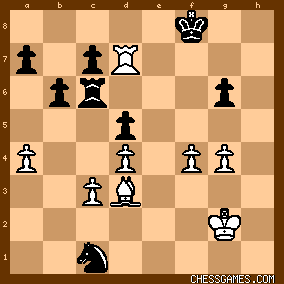
click for larger view33.Bb5 Rxc3 34.Rxd5 c6 35.Rd8+ Ke7 36.Rc8 Kd6 37.Ba6 Nb3 38.Rg8 Nxd4 39.Rxg6+ Kd5 40.f5 Ra3 41.f6 Ne6 42.Rg8 Rxa4 43.Bc8 Rf4 44.g5 a5 45.Kg3 Rf1 46.Bxe6+ Kxe6 47.Re8+ Kf7 48.Re7+ Kf8?> 48...Kg6 is the only move. The game is a draw after 32...Nc1. |
|
| Feb-24-09 | | notyetagm: 35 ?

click for larger view35 ♔f3-g3!
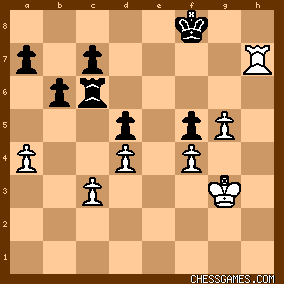
click for larger view<Decisive! White sacrifices material in order to obtain <<<the classical position with King on f6, pawn on g6, and Rook on h7>>>, whereupon the black pawns tumble like ripe apples. -- Alekhine> And you wonder why this game goes straight into my Game Collection: Position comes first, material second -- Capa. |
|
| Feb-28-09 | | Shams: <is this the most brilliant endgame ever? Alekhine and Capablanca are probably the greatest endgame players of all time.> Tartakower himself was no slouch.
"When Nimzowich wrote in <My System> that Tartakower was one of the three greatest endgame players alive, the common response was not doubt but rather speculation about the identity of the other two. (Was it Capablanca and Maroczy? Rubinstein and Lasker?)" --Andrew Soltis, "Karl Marx Plays Chess" |
|
| Feb-28-09 | | Shams: I find rook endings simply brutal, maybe you guys can help. I've been playing out the position right before white trades into the pure rook ending here, against crafty: http://www.chessvideos.tv/capablanc... Crafty deviates early from Tartakower's defense, playing 36...Rc1 instead of ...Rf3. After 37.Kh5 Crafty plays ...Rf1-- he was playing for the cheapo 37.g6?? when black trades into an easily won pawn ending. So here I am, after two moves already a tempo to the good and I'm still bungling things: 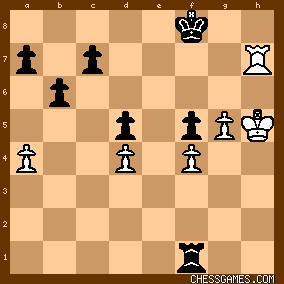
click for larger view
making this my starting position.
i) 1.Kg6 Rxf4 2.Rxc7 Rxd4 3.Kf6 Rc5, and is there still a win after this? 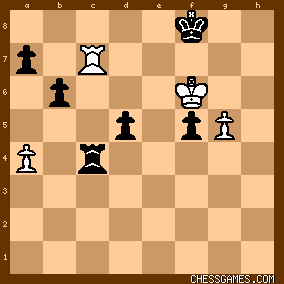
click for larger viewI've been losing after 4.Rxa7 Re6 5.Kxf5 d4, but I'll stop looking if the diagram above has already squandered the win. ii)1.Kg6 Rxf4 2.Rxc6 Rxd4 3.Rxa7 f4 4.Kf6 Re4
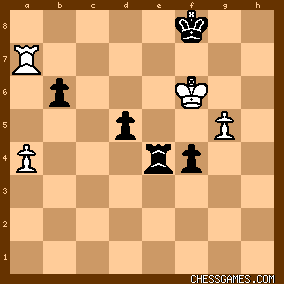
click for larger view
now I've been playing 5.g6 Re8 and still losing. am I on the right track? |
|
| Feb-28-09 | | crwynn: You should not be taking on c7 so soon. Kf6, g6 and mate or win of the rook is White's main idea, grab pawns only when Black has defended against that. |
|
 |
 |
|
< Earlier Kibitzing · PAGE 5 OF 14 ·
Later Kibitzing> |





